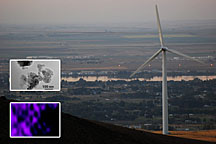- Number 362 |
- May 7, 2012
New alloy electrode designed for plus-sized ions

Thanks to fundamental research at
Pacific Northwest National Laboratory,
sodium-ion batteries could be part of
storing energy from wind farms and
releasing that electricity on demand.
Storing wind farm energy and releasing it on demand requires high-capacity, low-cost batteries; sodium-ion batteries could be part of the answer, thanks to fundamental insights from scientists at DOE’s Pacific Northwest National Laboratory. Instead of force-fitting larger sodium ions into battery electrodes built for much smaller lithium ions, the researchers designed an electrode based on the ion's character, not its circumference.
The new electrode or anode is built from a tin and antimony alloy, with a specially designed carbon support. Based on microscopy work at EMSL and other examinations, the team believes the tin- and antimony-rich phases that likely formed during the battery's operations support one another. When one phase becomes disconnected, the other phase takes up the slack, remaining stable and continuing to interact with the sodium.
"People have shown that the alloy reaction can work for lithium-ion batteries," said Dr. Jun Liu, director of PNNL’s Transformational Materials Science Initiative. "But, nobody had showed that similar reactions could work for sodium. Our paper is the first to show that you can use the alloy reaction to store sodium ions in the anode."
This durable new material can store nearly twice as much energy as a carbon electrode in the popular lithium-ion battery. The lithium-ion battery is too expensive for large-scale storage. Sodium-ion batteries require less expensive materials, but don’t have the capacity or durability desired. The new alloy from PNNL could be vital to creating a durable, high-capacity anode. DOE’s Office of Basic Energy Sciences funded this work.[Kristin Manke, 509.372.6011,
kristin.manke@pnnl.gov]
